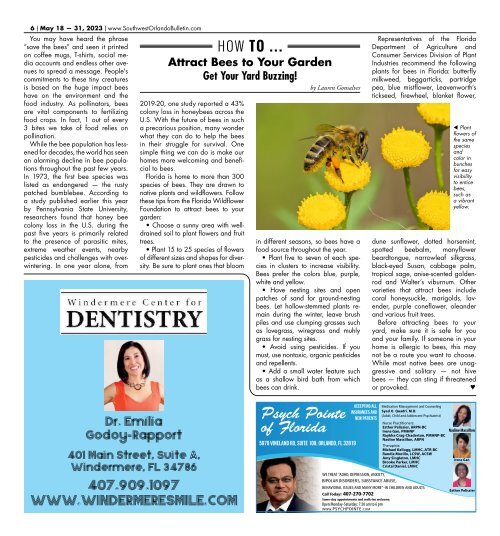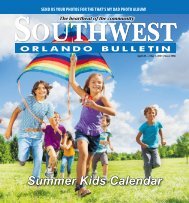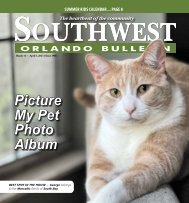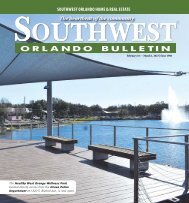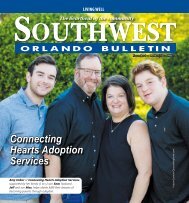051823_Spring Real Estate Directory _DIGITAL EDITION
You also want an ePaper? Increase the reach of your titles
YUMPU automatically turns print PDFs into web optimized ePapers that Google loves.
6 x May 18 — 31, 2023 x www.SouthwestOrlandoBulletin.com<br />
You may have heard the phrase<br />
“save the bees” and seen it printed<br />
on coffee mugs, T-shirts, social media<br />
accounts and endless other avenues<br />
to spread a message. People's<br />
commitments to these tiny creatures<br />
is based on the huge impact bees<br />
have on the environment and the<br />
food industry. As pollinators, bees<br />
are vital components to fertilizing<br />
food crops. In fact, 1 out of every<br />
3 bites we take of food relies on<br />
pollination.<br />
While the bee population has lessened<br />
for decades, the world has seen<br />
an alarming decline in bee populations<br />
throughout the past few years.<br />
In 1973, the first bee species was<br />
listed as endangered — the rusty<br />
patched bumblebee. According to<br />
a study published earlier this year<br />
by Pennsylvania State University,<br />
researchers found that honey bee<br />
colony loss in the U.S. during the<br />
past five years is primarily related<br />
to the presence of parasitic mites,<br />
extreme weather events, nearby<br />
pesticides and challenges with overwintering.<br />
In one year alone, from<br />
HOW TO ...<br />
Attract Bees to Your Garden<br />
Get Your Yard Buzzing!<br />
by Lauren Gonsalves<br />
2019-20, one study reported a 43%<br />
colony loss in honeybees across the<br />
U.S. With the future of bees in such<br />
a precarious position, many wonder<br />
what they can do to help the bees<br />
in their struggle for survival. One<br />
simple thing we can do is make our<br />
homes more welcoming and beneficial<br />
to bees.<br />
Florida is home to more than 300<br />
species of bees. They are drawn to<br />
native plants and wildflowers. Follow<br />
these tips from the Florida Wildflower<br />
Foundation to attract bees to your<br />
garden:<br />
• Choose a sunny area with welldrained<br />
soil to plant flowers and fruit<br />
trees.<br />
• Plant 15 to 25 species of flowers<br />
of different sizes and shapes for diversity.<br />
Be sure to plant ones that bloom<br />
in different seasons, so bees have a<br />
food source throughout the year.<br />
• Plant five to seven of each species<br />
in clusters to increase visibility.<br />
Bees prefer the colors blue, purple,<br />
white and yellow.<br />
• Have nesting sites and open<br />
patches of sand for ground-nesting<br />
bees. Let hollow-stemmed plants remain<br />
during the winter, leave brush<br />
piles and use clumping grasses such<br />
as lovegrass, wiregrass and muhly<br />
grass for nesting sites.<br />
• Avoid using pesticides. If you<br />
must, use nontoxic, organic pesticides<br />
and repellents.<br />
• Add a small water feature such<br />
as a shallow bird bath from which<br />
bees can drink.<br />
Representatives of the Florida<br />
Department of Agriculture and<br />
Consumer Services Division of Plant<br />
Industries recommend the following<br />
plants for bees in Florida: butterfly<br />
milkweed, beggarticks, partridge<br />
pea, blue mistflower, Leavenworth’s<br />
tickseed, firewheel, blanket flower,<br />
Plant<br />
flowers of<br />
the same<br />
species<br />
and<br />
color in<br />
bunches<br />
for easy<br />
visibility<br />
to entice<br />
bees,<br />
such as<br />
a vibrant<br />
yellow.<br />
dune sunflower, dotted horsemint,<br />
spotted beebalm, manyflower<br />
beardtongue, narrowleaf silkgrass,<br />
black-eyed Susan, cabbage palm,<br />
tropical sage, anise-scented goldenrod<br />
and Walter’s viburnum. Other<br />
varieties that attract bees include<br />
coral honeysuckle, marigolds, lavender,<br />
purple coneflower, oleander<br />
and various fruit trees.<br />
Before attracting bees to your<br />
yard, make sure it is safe for you<br />
and your family. If someone in your<br />
home is allergic to bees, this may<br />
not be a route you want to choose.<br />
While most native bees are unaggressive<br />
and solitary — not hive<br />
bees — they can sting if threatened<br />
or provoked. ª<br />
Dr. Emilia<br />
Godoy-Rapport<br />
401 Main Street, Suite A,<br />
Windermere, FL 34786<br />
407.909.1097<br />
WWW.WINDERMERESMILE.COM<br />
Nurse Practitioners:<br />
Esther Pelissier, ARPN-BC<br />
Irene Gan, PMHNP<br />
Raykha Crag-Chaderton, PMHNP-BC<br />
Nadine Massillon, ARPN<br />
Therapists:<br />
Michael Kellogg, LMHC, ATR-BC<br />
Randie Morillo, LCSW, ACSW<br />
Amy Singleton, LMHC<br />
Brooke Parker, LMHC<br />
Cristal Daniel, LMHC<br />
Nadine Massillon<br />
Esther Pelissier


